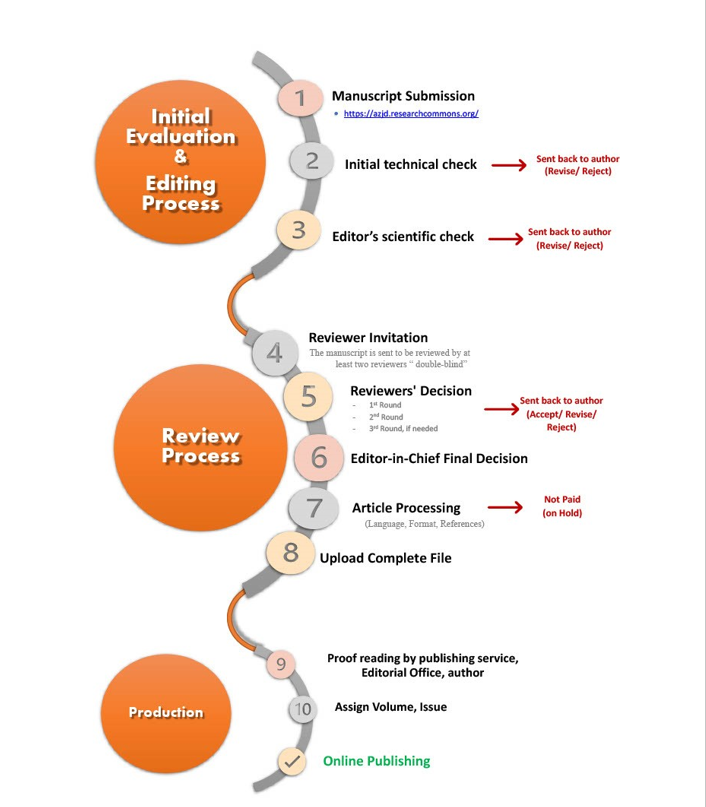Peer Review Process
Initial evaluation
The Editor in Chief makes sure all manuscripts meet Al-Azhar Journal of Dentistry guidelines as prescribed in the author’s guidelines. Manuscripts may be rejected without peer review by the Editor-in-Chief if they do not comply with the submission guidelines or if they are beyond the scope of the journal.
All manuscripts are first screened and checked for plagiarism using “Ithenticate” software
Manuscript editor checks the scientific level of the manuscript and decides whether to invite reviewers. If manuscript editor decides that the scientific quality of the manuscript is not good enough, then he/she gives a “reject” decision and sends manuscript back to Editor-in-Chief. The Editor reserves the right to reject a manuscript on the grounds of insufficient language quality. Reject decisions at this stage will be verified by the Editor-in-Chief.
If manuscript editor decides that the manuscript has a high scientific quality, then he/she invites reviewers.
The average time from submission to first decision will be 2-3 weeks.
The manuscript that passes the initial evaluation will be sent to be reviewed by at least two reviewers who have areas of expertise related to the submitted manuscripts. The reviewing process is double blind (the names of the reviewers are hidden from the author, and the name of the author/s is hidden from the reviewers)
During the review process, editors do not disclose any information about the submission to anyone other than the corresponding author, reviewers, potential reviewers, and other editorial advisers. Any manuscripts received for review be treated as confidential documents. Editors make every effort to ensure that peer review is fair, unbiased, and timely. Manuscripts deemed suitable are sent to a minimum of two external peer reviewers to assess the scientific quality of the paper. The selection of peer reviewers is made by the article-handling editor (the Editor-in-Chief or the specialist editor). Authors are requested to suggest reviewers but the editors reserve the right of the final selection.
Reviews are conducted objectively and include supporting arguments for observations so that authors can use them for improving the paper. The journal encourages reviewers to comment on ethical questions and possible misconduct raised by submissions (e.g., unethical research design, insufficient detail on patient consent or protection of research subjects [including animals], inappropriate data manipulation), and to be alert to redundant publication and plagiarism.
This journal operates a double-blind review process. After completing all reviewers' reports, the editor in chief makes a decision (accept, major revision, minor revision or reject). The authors receive from 1 to 2 weeks to prepare the revision depending on the reviewers' comments. Any revisions should be clearly highlighted, for example using red color for the texts and a yellow highlight on the text, so that they are easily visible to the editors and reviewers. The authors should provide a response to reviewers' comments detailing any changes. The revisions that have been made should be detailed citing the line number and exact change so that the editor can check the changes expeditiously. Revisions that do not meet these requirements will be sent back to authors with requests for corrections and resubmission. Some articles may have two or three rounds of peer review. The average duration of the submission to the first decision is 2-3 weeks. The average duration of the submission to the final decision is 10-12 weeks. The Editor-in-Chief is responsible for the final decision regarding the acceptance or rejection of articles. The Editor's decision is final.
After a manuscript is accepted for publication, i.e. after reviewer-recommended revisions are complete, the author will not be permitted to make changes that constitute departures from the manuscript that was accepted by the editor. Before publication, the galley proofs are always sent to the authors for corrections.
Flowchart of the Journal Publication Process









